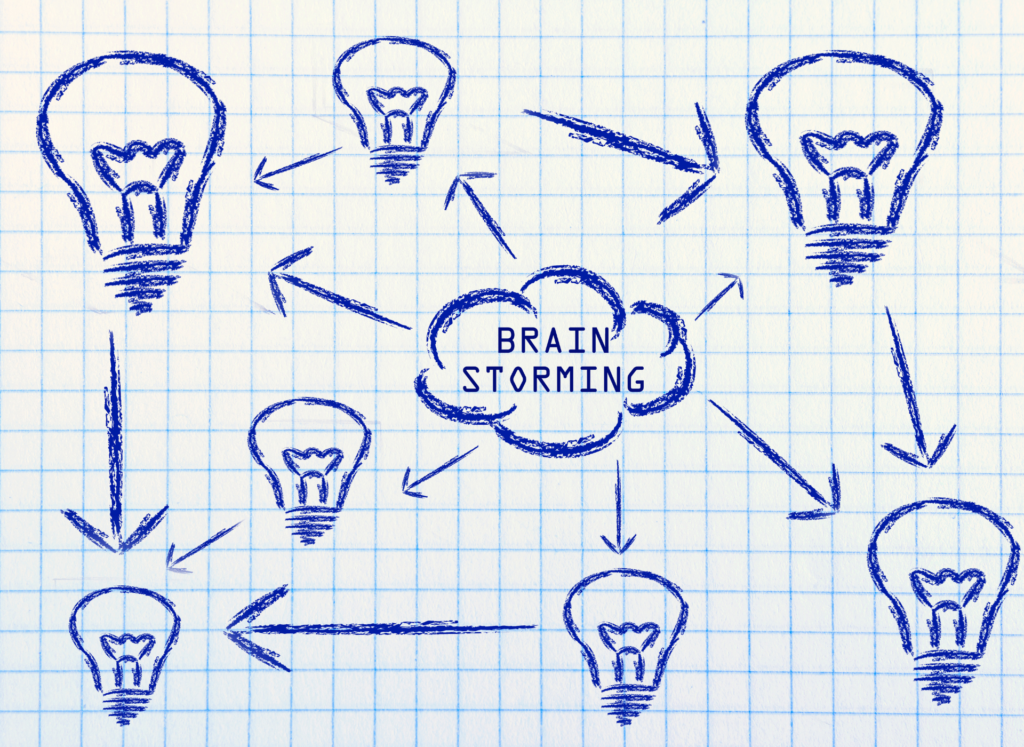Brainstorming, also known as brainstorming in English, is a creativity technique used to generate a large number of ideas in a short time.
It’s a great way to spark creativity and innovative thinking in any project or problem.
In this step-by-step guide, we’ll explain how to brainstorm effectively, from choosing the topic to selecting the best ideas generated.
By following this process, you can come up with unique and creative ideas to tackle any challenge you may encounter in your personal or professional life.
What is Brainstorming?
Brainstorming is a creative technique for generating group ideas. It was developed in the 1940s by publicist Alex Osborn, who proposed that people gather in an environment free of judgment and criticism to generate a “brainstorm of ideas”.
The goal is to create an open and collaborative environment where all ideas are welcome, regardless of their viability or quality.
The idea behind brainstorming is that when people come together to generate ideas, they can overcome mental blocks and achieve breakthrough results.
Brainstorming can be used in a variety of contexts, from business meetings to classroom lessons.
What is the difference between Structured and Unstructured Brainstorming?
Structured brainstorming follows a previously defined agenda or script, with well-defined steps and rules to conduct the brainstorming session. It is usually led by a facilitator who guides the group through each step and records the ideas generated.
Unstructured brainstorming, on the other hand, is a freer session of ideas, without a defined script, allowing participants to express their ideas more spontaneously and without restrictions.
In this case, there is no need for a facilitator or formal registration of ideas, allowing the discussion to flow more freely.
Both types can be effective depending on the situation and the purpose of the session.
What is Brainstorming for?
The brainstorming brainstorm serves to generate creative and innovative ideas collaboratively.
It is a valuable technique for problem-solving, project development, and decision-making in different sectors, such as companies, schools, and research groups.
The importance of implementing Brainstorming lies in providing an environment conducive to the creation of ideas without restrictions, promoting the participation and engagement of all team members, and stimulating creativity and innovation.
With Brainstorming, it is possible to generate more creative ideas and expand the range of options to solve problems or achieve goals, resulting in more effective and successful projects.

What is the importance of using Brainstorming?
Brainstorming is an important tool to generate creative and innovative ideas in a group.
Through the collaboration of different individuals with diverse perspectives and experiences, it is possible to explore a wide range of solutions and possibilities.
Furthermore, after understanding what brainstorming means, we can see that this instrument encourages the participation of all members, without judgment or initial criticism, which makes it possible to present ideas that might not arise in a traditional discussion.
This collaborative approach, free of premature criticism, can lead to more effective and unique results.
When to use Brainstorming?
Brainstorming can be used in different contexts, such as team meetings, strategic planning sessions, innovation processes, and problem-solving, among others.
It is especially useful when there is a need to generate new and creative ideas, explore different perspectives and points of view, and encourage the active and collaborative participation of team members.
It is an effective tool for stimulating creativity, fostering teamwork, and finding creative and innovative solutions to complex challenges.
Brainstorming can be used in both formal and informal work teams, and it is an accessible and easy-to-implement technique.
What are the types of Brainstorming?
Different types of brainstorming can be used according to the needs of the group and the objective of the activity. In this block, we will present four types: Slip Writing, Stepladder Technique, Brainwriting, and Brain-netting.
Each of these methods has specific characteristics that can help improve creativity, participation, and collaboration among group members.
The choice of the type of Brainstorming to be used will depend on the needs and objectives of the team and the context in which the activity will be carried out.
1. Slip Writing
Slip Writing is a Brainstorming technique that encourages participants to write down their ideas on small pieces of paper or slips.
Each participant writes their ideas on a separate slip, without worrying about the organization or the quality of the ideas. Then the slips are collected and organized into categories for further discussion.
This technique is especially useful for ensuring that all voices are heard and for encouraging individual creativity.
In addition, it allows participants to generate a large number of ideas in a short time, which is ideal for projects that require innovative solutions.
2. Stepladder technique

The Stepladder technique is a brainstorming meeting structure that allows all ideas to be considered without interruption or premature criticism.
This technique involves forming a small initial group that presents and discusses ideas independently before adding additional members one-on-one.
As each new member is added, they are informed of previously discussed ideas and encouraged to share additional ideas.
This technique helps to avoid peer pressure and allows everyone a chance to contribute ideas in a meaningful way.
3. Brainwriting
The Brainwriting technique is a variation of group brainstorming, in which each participant individually writes their ideas on a piece of paper.
Afterward, these papers are randomly collected and redistributed among the participants, who continue to develop and improve the ideas already written by other members.
The aim is to allow everyone the opportunity to present their ideas without pressure or influence from the group and also to prevent a strong idea or a dominant personality from influencing the direction of the discussion.
With this, you can get a lot of different and creative ideas.
4. Brain-netting
The Brain-netting technique is a variation of online brainstorming aimed at solving specific problems. It is especially useful when the problem is complex and involves a lot of detail and information that needs to be organized and connected to generate effective solutions.
In this technique, each team member writes ideas and suggestions on a piece of paper, and then these papers are exchanged and discussed together. The ideas are connected in a mind map, helping to visualize the connections between them.
Brain-netting helps eliminate the influence of dominant ideas and ensures that all team members have the opportunity to share their ideas and perspectives.
How to do a Brainstorming (rain of ideas) in 8 steps?
To run an effective brainstorming session, it’s important to follow a well-defined set of steps. This helps ensure that the session is productive and generates relevant and actionable ideas.
In this block, we will present the step by step to carry out a brainstorming session in eight stages, from the definition of the objective to the evaluation and prioritization of the generated ideas.
These steps include defining the objective, choosing the stakeholders, establishing the rules, setting a time limit, opening up to all ideas, brainstorming, recording the ideas, and evaluating and prioritizing the generated ideas.
1. Define the objective
The first step to a successful brainstorming session is clearly defining the objective.
The objective must be specific and focused, to ensure that the session is productive and the ideas generated are relevant and useful in achieving the established objective. All participants must understand and agree with the objective so that everyone can collaborate and work together to achieve it.
In addition, the objective must be challenging, but also achievable so that the participants can feel motivated and engaged in the brainstorming session.
2. Define the stakeholders
When defining stakeholders, it is important to determine who will be the participants in the brainstorming session. This means choosing people who have experience and knowledge about the previously defined objective and who will be able to contribute relevant ideas.
These participants must be committed and involved in the process. Depending on the objective and theme, it can be useful to involve people from different areas or departments of the company to gain different perspectives and knowledge.
Make sure you have a diverse group that can bring different ideas and opinions to the table.
3. Establish the rules
Establishing rules is essential to ensure that the brainstorming process takes place in an organized and respectful manner. The rules must be defined and agreed upon by all participants before the start of the activity.
Some common rules include: not judging or criticizing ideas, allowing all ideas to be expressed, avoiding interruptions, and keeping the focus on the proposed theme, among others.
Establishing these rules can help avoid conflict and create a safe and productive environment for sharing ideas.
4. Set a timeout
Setting a time limit is essential to ensure that Brainstorming doesn’t go on too long and becomes unproductive. It’s important to set a deadline so that all participants know how much time they have to contribute their ideas.
The ideal time for Brainstorming may vary according to the objective and the number of participants, but it is generally recommended that it last from 30 minutes to 1 hour.
It is important to respect the defined time and end of Brainstorming when the deadline ends so that the phase of evaluating ideas and prioritizing the most relevant ones can begin.

5. Give space to all ideas
During the brainstorming session, it is essential to give space to all ideas, regardless of their viability or relevance. Encourage participants to think outside the box and share their ideas without fear of criticism or judgment.
It is important to remember that during the brainstorming session, the objective is to generate as many ideas as possible, without censoring or filtering anything.
Encourage everyone to share their ideas freely without fear of being judged or rejected, even if they seem unconventional or difficult to implement.
The diversity of ideas is critical to the effectiveness of the brainstorming session.
6. Start Brainstorming
After proper preparation, it’s time to start brainstorming. The session leader can start the process by explaining the purpose and rules again.
Then, he can launch a question or a topic related to the defined objective to stimulate the discussion.
Participants should be encouraged to share their ideas freely without fear of judgment or criticism. Everyone involved actively must participate, contributing their ideas and listening carefully to the ideas of others.
The session must be conducted smoothly, without interruptions or prolonged debates, to ensure the productivity and creativity of the process.
7. Record all ideas
During the brainstorming process, it is essential to record all proposed ideas, regardless of their relevance or practicality.
This means that each suggestion must be written down in a space visible to all participants so that they can be discussed and evaluated later.
Some useful tools for recording ideas are the use of flipcharts, sticky notes, or even a whiteboard. The notes of ideas should be made clearly and concisely so that they can be easily understood and remembered by those involved.
In addition, it is important to record ideas objectively, without adding comments or prior judgments.
8. Evaluate the ideas and prioritize the ones that make the most sense
After the established time has expired, it is important to evaluate the ideas generated during the brainstorming. This can be done through a process of sorting, selecting, and prioritizing the ideas that stand out the most and prove to be the most viable.
It is important to consider the previously established criteria, as well as the relevance and viability of the ideas.
Then, the selected ideas can be improved and deepened, seeking to transform them into practical and effective solutions for the established problem or objective.
The evaluation and prioritization of ideas allow Brainstorming to be even more productive and effective, ensuring that the best solutions are developed based on the collective creativity of the team.
Conclusion
Brainstorming is a powerful tool to stimulate creativity and innovation in work teams. By following the 8 steps, it is possible to get a lot of valuable ideas in a short time.
However, it is important to remember that the quality of the ideas generated depends on the commitment of all participants to follow the established rules and to give space to all ideas, even the seemingly craziest ones.
In addition, the ideas generated must be evaluated and prioritized so that the team can choose the ones that make the most sense to the established objective.
Thus, Brainstorming can be an effective tool to generate innovative and creative solutions in several areas, from the development of new products to the solution of complex problems.



